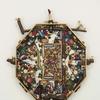SEVEN SAGES OF CERAMICS: MODERN JAPANESE MASTERS
- NEW YORK, New York
- /
- January 09, 2013
This spring, Joan B. Mirviss, Ltd. is proud to present a groundbreaking exhibition, Seven Sages of Ceramics; Modern Japanese Masters, organized in collaboration with the leading modern ceramic dealer in Japan, Shibuya Kuroda Toen. This is the concluding exhibition of our thirty-fifth anniversary year and follows two years after our critically acclaimed exhibition, Birds of Dawn: Pioneers of Japan’s Sōdeisha Ceramic Movement. Our accompanying, fully illustrated catalogue includes an insightful essay by Kida Takuya, curator at the National Museum of Modern Art, Tokyo.
This exhibition focuses on seven modern masters of the clay medium–– all creative virtuosi as well as brilliant technicians. Spanning a period of more than fifty years, starting just prior to WWII, these artists were at the vanguard of Japanese clay art, when it was poised to assume its present position as the most diversified and inventive in the world. These men transformed and surpassed the classical standard for functional ceramic excellence—devotion to the ancient Chinese traditions or allegiance to the late16th-century Momoyama tea wares, thought to be the golden-age acme of Japanese ceramics—and brought to their oeuvres a new, modern, and highly influential sensibility.
Taken from the ancient theme of “the Seven Sages of the Bamboo Grove,” the show’s title references the third-century group of learned Chinese men who escaped the corruption and intrigues of the court to live in seclusion, often meeting in a bamboo grove where they held influential discussions about life, art and culture. This show features the work of seven Japanese masters of clay who are all enormously celebrated in Japan but remain largely unknown in the West: Arakawa Toyozō, Ishiguro Munemaro, Kamoda Shōji, Kawakita Handeishi, Kitaōji Rosanjin, Okabe Mineo and Yagi Kazuo. Each brought new light and creativity to specific aspects of the ceramics field. Some focused on new interpretations of classic tea wares of the Momoyama era while others sought to meld tradition with highly personal interpretations. Like the Seven Sages, these seven, featured artists distanced themselves from the ceramic establishment and brought their unique independent spirit, passion and talent to their art form. Many of the artists never had the opportunity to communicate or collaborate with each other, so this exhibition provides a visual forum or virtual “bamboo grove.” Individually and as a group, they paved the way for the succeeding post-war generation of clay artists who collectively have been referred to as the new Golden Age of Japanese Ceramics.
the artists
Born in Mino, Arakawa Toyozō (1894-1985) changed Japanese ceramic history with his famous discovery of the true origin of shino ceramics on a shard with a bamboo shoot pattern found at Mutabora, where in 1933, he established his kiln. In 1955, he was the first of four ceramists to be designated, as what came to be known, a Living National Treasure, and was honored for his powerful Momoyama-inspired shino and setoguro (black seto) functional work.
Ishiguro Munemaro (1893-1978) won the Silver Prize at the Paris Exposition of 1937 and was one of the first in 1955, along with Arakawa, to be selected as a Living National Treasure for his iron glaze. Ishiguro's nontraditional pieces, which were only exhibited in group shows, are marked by powerful potting and bold, vigorous designs. He was also a noted collector of Han and Song dynasty ceramics and composed Chinese poetry that he often incised on his vessels. Through his detailed study of Song material, he became the first to recreate that epoch’s glorious persimmon temmoku iron glaze.
Kamoda Shōji (1933-83) awakened the entire conservative Japanese traditional ceramic world to a new vision of the concept of “function.” Never satisfied with his work, Kamoda created infinitely varied shapes and forms with ever-changing innovative patterns that were not based on any previous style or tradition. His sold-out exhibitions led to a near-cult-like status. Thirty years after his pre-mature death at age 49, his works remain highly influential and among the most sought-after by important Japanese collectors and museums.
One of the artists to have the largest impact on the Japanese tea world was Kawakita Handeishi (1878-1963), a prosperous banker, who held several important financial positions but who also found time for calligraphy, painting, poetry and photography. At the age of fifty, Handeishi turned exclusively to the world of clay and brought new life to a then stagnant field. His very personal, charming, and delightful teabowls and other tea implements have influenced many young ceramists who in turn became masters.
Master of an enormous range of glazes, Kitaōji Rosanjin (1883-1959) produced superb functional vessels and tableware in stoneware and porcelain that were used in his celebrated and exclusive eating club in Kyoto. In addition to ceramics he painted and created lacquerware. A friend of Noguchi Isamu, towards the end of his life Rosanjin traveled to the US and Europe, where his work was already receiving broad recognition. When selected in 1955 for Living National Treasure designation for his mastery of oribe, he indignantly declined the honor as Arakawa, his former apprentice, had already been selected for shino ceramics.
Although born into a famous ceramic family, Okabe Mineo (1919-90) fought throughout his youth to avoid such a career. However, he was forced to return to that world after imprisonment in the Philippines during WWII, where upon he struggled to survive as an impoverished potter. Starting in the early 1950’s, with new bold work inspired in part by ancient Jōmon vessels but covered in his uniquely brilliant blue-green oribe (ao-oribe) glaze, Okabe began to win prestigious prizes. About ten years later, he tackled the very difficult cracklure celadon glaze with extraordinary results, making some of the most beautiful celadons ever created.
Yagi Kazuō (1918-79) was the central figure and spokesman for the Sōdeisha group that was founded in 1948 and revolutionized the idea of ceramics in Japan. While focused on “objets” that were neither purely sculptural nor functional, he respected utility and incorporated the western aesthetics of artists such as Paul Klee and Joan Miro into his distinctly Japanese forms. Yagi became the standard bearer of this field and revolutionized the perception of ceramics in postwar Japan through today.
the organizers
Founded in 1969, Shibuya Kuroda Toen has been the leading gallery for prominent exhibitions of master ceramists as well as a platform for launching new talents. Its major solo shows have ranged from the works of Rosanjin, Okabe, and Kamoda, to group exhibitions of the masters of the Showa era. Originally located in central Ginza in Tokyo, the gallery moved to the fashionable Minami Aoyama area in 1979 before opening its current location in 1980, in the Shibuya area of Tokyo.
Joan B. Mirviss is the leading Western dealer in the field of modern and contemporary Japanese ceramics, and from her gallery on Madison Avenue, Joan B. Mirviss LTD exclusively represents the top Japanese clay artists. As a widely published and highly respected specialist in her field for over thirty-five years, Mirviss has advised and built collections for many museums, major private collectors, and corporations.
Joan B. Mirviss LTD is located at 39 East 78th Street in New York and is open Monday through Friday 11am-6pm and by appointment.
March 14 – April 26, 2013
Joan B Mirviss LTD
39 east 78TH street new york, ny









__2016_100x100_c.jpg)


![Peter Paul Rubens (Flemish, 1577–1640), After Titian (Tiziano Vecelli) (Italian [Venetian], c. 1488–1576), Rape of Europa, 1628–29. Oil on canvas, 71 7/8 x 79 3/8 in. Peter Paul Rubens (Flemish, 1577–1640), After Titian (Tiziano Vecelli) (Italian [Venetian], c. 1488–1576), Rape of Europa, 1628–29. Oil on canvas, 71 7/8 x 79 3/8 in.](/images/c/e2/2e/Jan20_Rape_of_Europa100x100_c.jpg)



